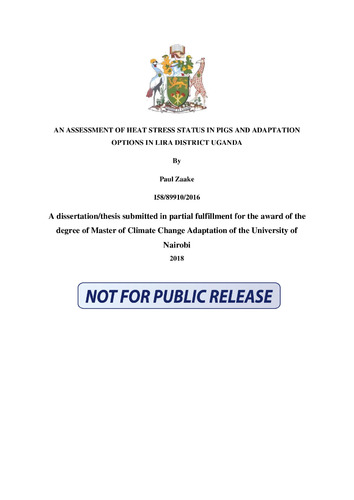An assessment of heat stress status in pigs and adaptation options in Lira district Uganda
There is limited attention to impacts of climate change on pigs in Uganda by stakeholders despite the potential vulnerability of pigs to climate change, especially heat stress. Pigs are very sensitive to heat stress as they do not have functioning sweat glands (as other livestock species do) and have small lungs which reduces their ability to disseminate heat by panting. The objectives of the study were to determine the heat stress status in pigs, factors influencing heat stress and explore the heat-stress adaptation options towards better pig production in Lira District, Uganda. Lira was selected because of low pig density, high poverty level and expected heat stress throughout the year in the district. The data including management systems, age, color, breeds, body/skin temperature, rectal temperature and others were collected from 104 households and 259 pigs during the hot months in Ojwina and Barr sub-counties- Lira district. More data on adaptation options were collected during the four gender disaggregated focus group discussions. 63.46 % of the respondents were female and 36.54% of respondents were male. Majority of the respondents during the household survey were from Barr sub-county (56%) and the remainder (44%) were from Ojwina sub-county, which were the rural area and urban area respectively. Rectal temperature (RT=39.06°C ±0.83°C) and body/skin temperature (ST=36.32°C ±2 °C) were the key heat stress indicators (dependent variables) as have been used by other researchers. According to the farmers, 48.45% of the pigs had no heat stress, 51.55% of the pigs were heat stressed and these groups were significantly different (p<0.01). There was a statistically significant correlation between heat stress status and heat stress action (p<0.01). The results showed that rectal temperature is influenced by the external temperature humidity index, pig management system, pig category, color, heart girth, water quantity given during day in dry season, pig’s body condition score, and time of the day. The results showed that skin temperature is significantly influenced by external temperature humidity index, pig category, pig management, time of the day and body condition score. According to the farmers, the most preferred adaptation options (using a rating scale of 1 to 5 where 1 was the least preferred option and 5 the highest preferred) to heat stress included: constructing a high pig pen roof and allow easy air flow (Average Preference Rating =APR=4.75); pouring water on the pigs (APR=4.63); allowing pigs to swim/wallow (APR=4.48). Allowing pigs to rest by not disturbing them (APR=4.38); providing more water for drinking to pigs (APR=4.33); reducing stocking density (APR=4.30); constructing well-designed pigsty (APR=4.25); providing shade (APR=4.07); mixing/addition of water to the feed (APR=4.07); and constructing grass thatched pigsty (APR=4.00). The medium preferred adaptation options to heat stress included feeding pigs during the coolest time of the day (APR=3.75); pouring water on the ground/floor (APR=3.73); leaving door of the pigpen open for more air circulation (APR=2.45); and chopping feeds into small particles (APR=2.25). The least preferred adaptation options to heat stress included giving salt to replace lost electrolytes (APR=1.25); and addition of fans (APR=1.03). Between 4.81% and 100% of survey-respondents who had heard of an adaptation-option had applied it for all adaptations options. The percentage of the female members of the household making decisions and providing labour for particular adaptation options was higher relative to the male household members and non-household members; except for the adaptation option of constructing the pig houses. To adapt to heat stress, pig shelters should be designed to minimize overcrowding while incorporating ways to improve air flow and evaporative cooling by having a high roof, and / or using grass. Availing water ad lib or even mixing water in the feed is critical to reducing heat stress. Pig swimming/wallowing and pouring water on the pigskin are some of the interventions farmers may use. However, there is need for more awareness about the suitable adaptation option to heat stress while putting the local context into consideration.

